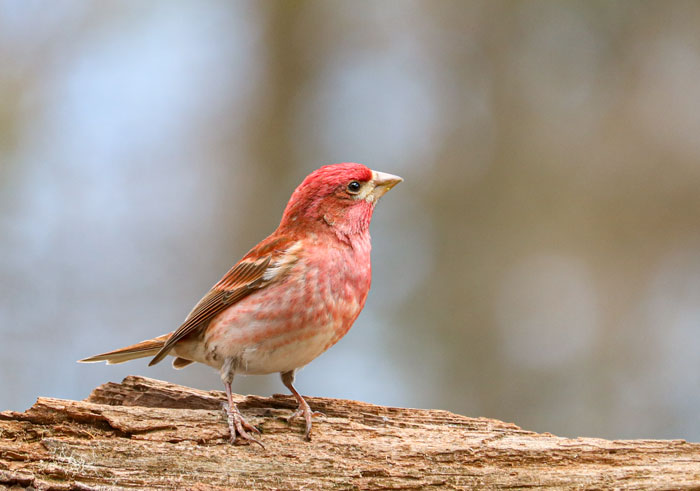
As a vibrantly-colored visitor of bird feeders, the purple finch Haemorhous purpureus brings quite a lot of aesthetically pleasing qualities to its environment. The males are not exactly purple, but more of a delicate pink-red with a raspberry-colored head. The females lack the vibrant colors of the males, but what they lack in color they sure make up for in personality, as they are quite feisty. I thoroughly enjoy watching these colorful birds at my feeders throughout the year.
Although recently, I have noticed fewer purple finches at my feeders, especially this winter. I’m not sure if this will be a permanent occurrence or if I will be seeing an increase in numbers as we transition into the spring season very shortly. After doing some research, I found some interesting information about the decrease in the overall numbers of these finches. According to the North American Breeding Bird Survey, purple finch populations have decreased by almost 1.5% per year between 1966 and 2014, resulting in a cumulative decline of 52%. Two factors for the decrease in these birds could possibly be factors such as competition and disease due to the introduction of other bird species.
Populations have also declined sharply here in the east from the competition with the house finch Haemorhous mexicanus. When these two species collide, the house finch outcompetes the purple finch. This bird has also been displaced from some habitats by the introduction of the house sparrow Passer domesticus, which is considered to be an invasive species. House sparrows travel in gangs and will attack and kill a variety of native-American bird species. Competition doesn’t seem to be an issue in my yard from the house finch or house sparrow. I have yet to see a house finch at my feeders or in the yard. I have very few house sparrows in my yard and visiting my feeders. These birds show up once a year during the spring. I think they come over from the horse rescue down the street as they like to take up residence in their barn as they prefer to nest in human-made structures.
In regard to disease, birds that have been infected with house finch eye disease (also called Mycoplasmal conjunctivitis) will have symptoms such as red, swollen, runny, or crusty eyes. In extreme cases of this disease, the eyes will become swollen shut and the bird becomes blind. You may observe an infected bird sitting quietly in your yard, clumsily scratching an eye against its foot or a perch. While some infected birds recover, many die from starvation, exposure, or predation. The disease has affected several other wild bird species, including the purple finch, American goldfinch Spinus tristis, and evening grosbeak Coccothraustes vespertinus. I have seen purple finches exhibiting symptoms of house finch eye disease in the past. In order to decrease the spreading of this disease, I take down all of my feeders to deter the birds from congregating in one place. I will also clean my bird feeders thoroughly and put them back out when I think the coast is clear.
You can do your part in helping these birds thrive by planting a variety of coniferous trees in your yard that may encourage these birds to visit and create a welcoming habitat for them. Providing food sources in your yard can help as well. Purple finches have large, seed-cracking beaks, and seem to enjoy black oil sunflower seeds the best. A seed preference study determined that they are partial to thinner sunflower seeds over wider seeds. Just remember in order to minimize the spread of disease, keep your feeders and birdbaths clean and only use fresh bird food.
I’m hoping to see the arrival of these birds soon. Hopefully, these birds being here in fewer numbers this winter was due to seeking out another food source and I’m not experiencing an overall decrease in their numbers. I look forward to seeing and hearing the males sing their distinctive song from the very tops of the trees and the gutsy females keeping the other birds in line at my feeders.
I would also like to share some information and a few facts about these fascinating finches, as well as provide a few resources for aiding in their identification.
Description of the Purple Finch
Purple finches are large and chunky forest birds. They have powerful, conical beaks that are larger than that of any sparrows. The tail is short and notched at the tip.
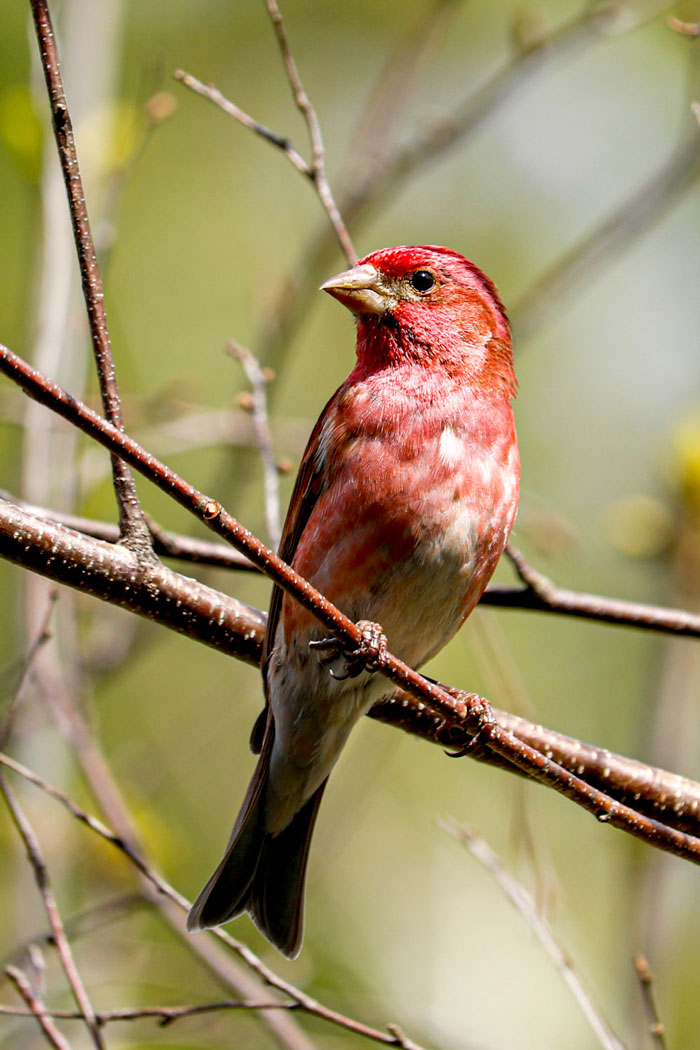
Male purple finches are a delicate pink-red color on the head and breast, mixing with brown on the back and a cloudy white on the belly.
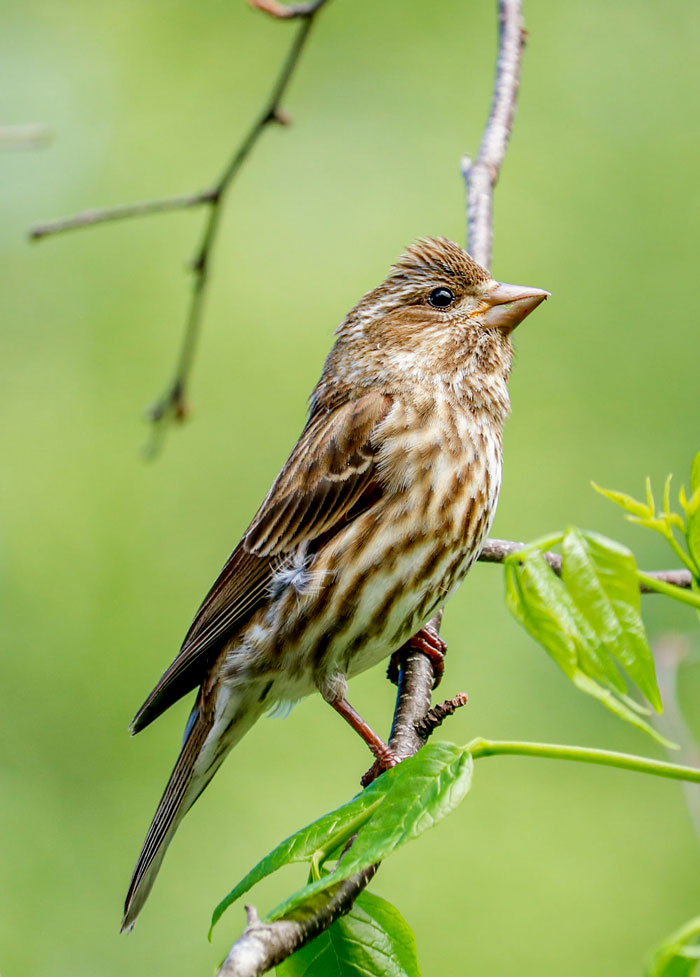
Unlike males, females have no red. They are coarsely streaked below, with strong facial markings including a whitish-color eyestripe and a dark line down the side of the throat.
The Female Purple Finch vs. the Female Rose-breasted Grosbeak
The female purple finch can often be mistaken for the female rose-breasted grosbeak due to their sharing similar coloring. Here are some helpful clues to help distinguish between these two often-confused female bird species.
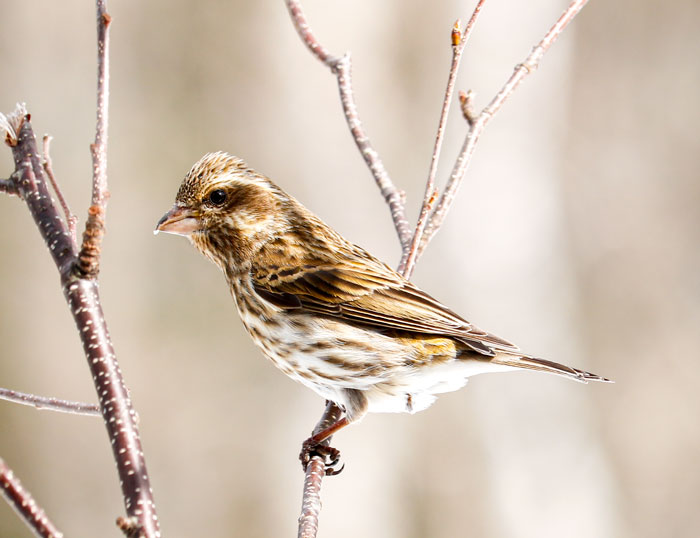
The female/immature purple finch is considerably smaller than the female rose-breasted grosbeak and also has a much smaller beak.
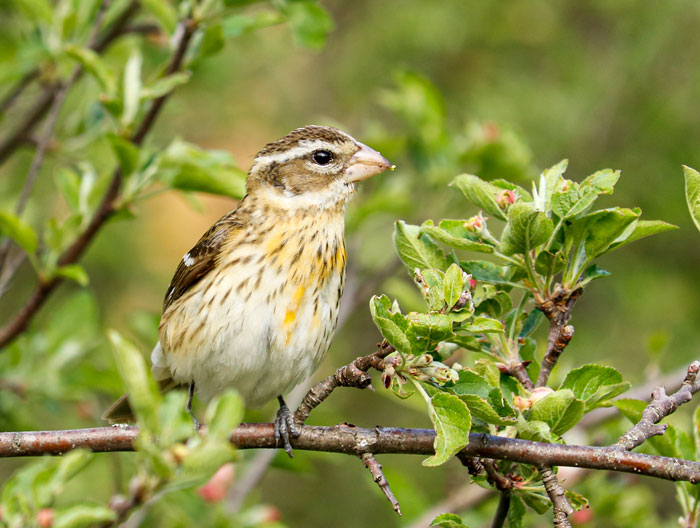
The female rose-breasted grosbeak Pheucticus ludovicianus is a much larger and stockier bird than the female purple finch. These birds have large and thick bills. They also have a boldface pattern with a strong whitish-color stripe over the eye and a warm buffish wash on the breast.
Purple Finch Habitat
During the summer, purple finches can be found primarily in moist and cool evergreen forests. These birds can also be found in mixed forests, along wooded streams, and in tree-lined suburbs. During the winter months, they are more widespread, using shrubby areas, fields with weeds, hedgerows, backyards, and woods.
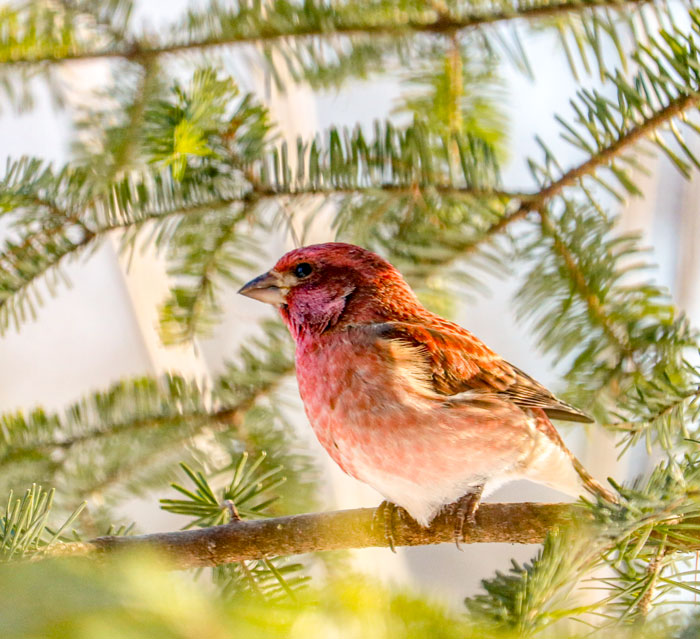
Purple Finch Behavior
Purple finches will readily come to your feeders for black oil sunflower seeds. You can also find them in forests, where they can be noisy but hard to see as they forage high in trees. During the winter, these birds may descend to eat seeds from plants and stalks in weedy fields.
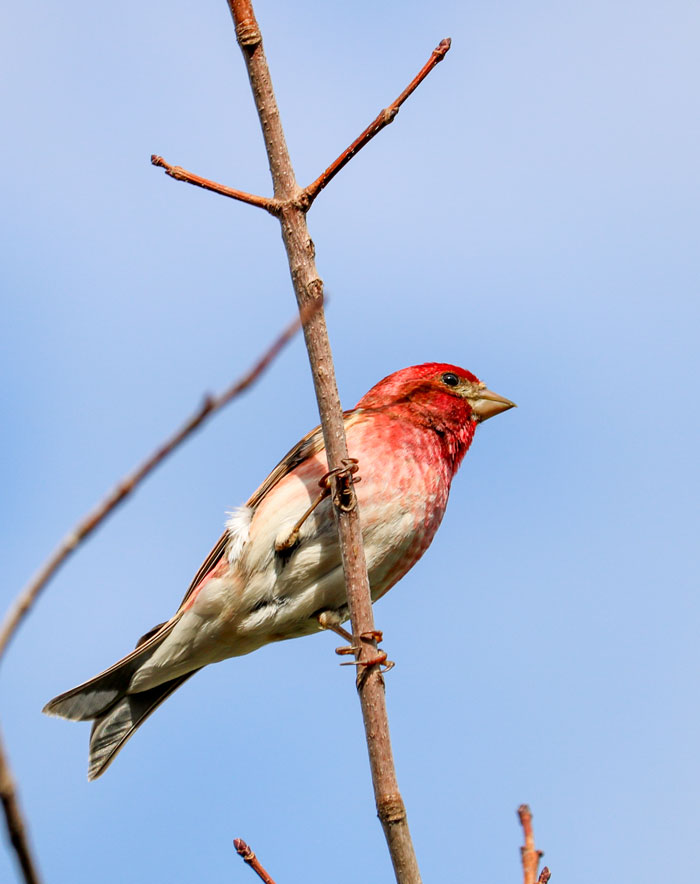
What Do Purple Finches Eat?
Purple finches forage in trees and bushes, sometimes in ground vegetation. They mainly eat seeds, berries, and insects. Their diets include mainly seeds of coniferous trees and elms, tulip poplars, and maples, as well as from others. They also eat soft buds as well as nectar they extract by biting the bases off of flowers.
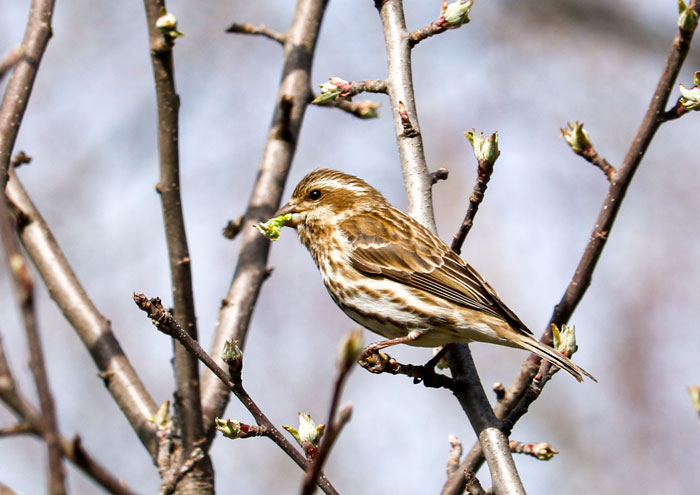
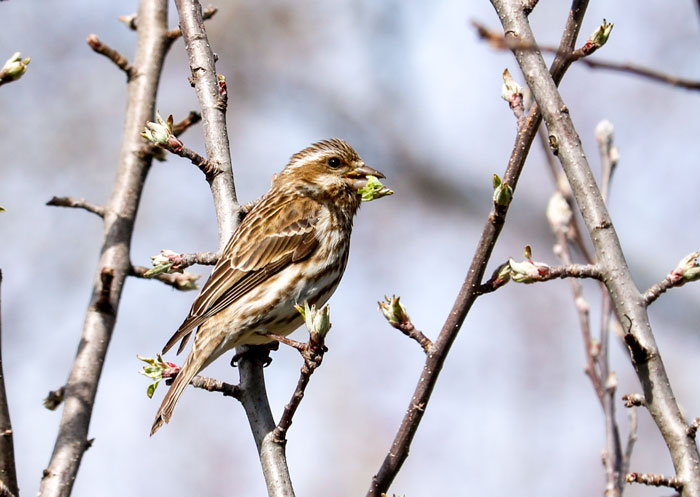
These birds also consume many berries and fruit, including blackberries, honeysuckle, poison ivy, crabapples, juniper berries, cherries, and apricots. In winter you may see purple finches eating seeds of low plants like dandelions, ragweed, and cocklebur. They eat some insects, including aphids, caterpillars, grasshoppers, and beetles.
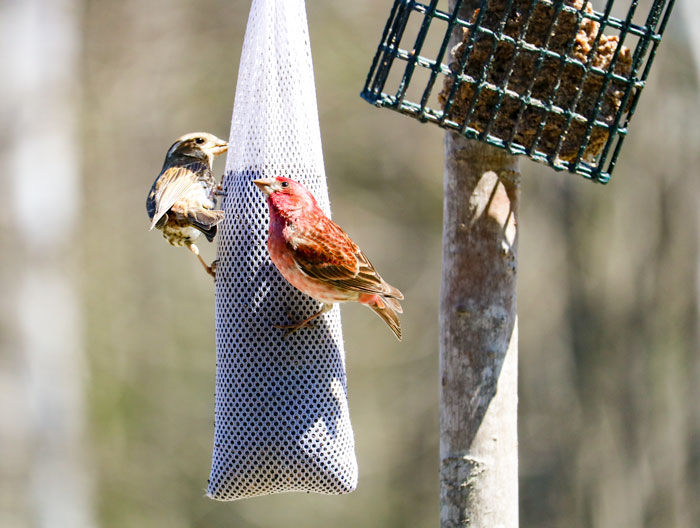
At bird feeders, these finches are quite fond of sunflower seeds, millet, and thistle.
Purple Finch Song
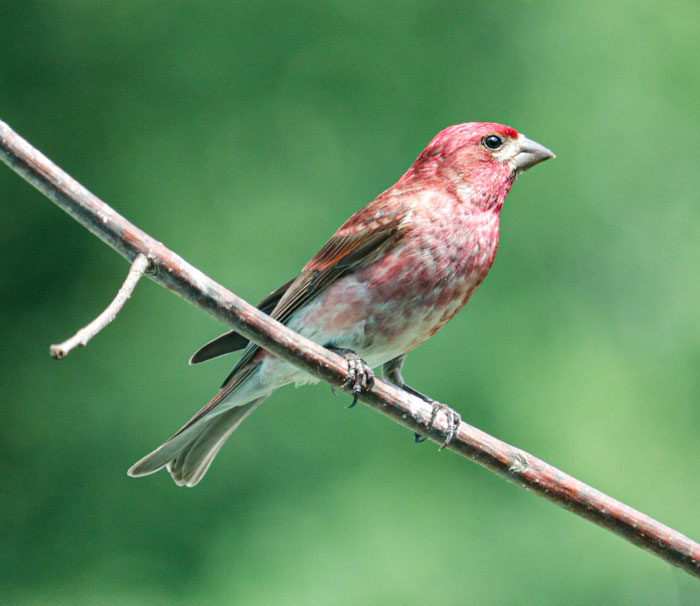
Male purple finches sing three kinds of songs, all including the rich, slurred warbling characteristic of finch songs. There is the “warbling song,” a fast, rising and a falling string of six to twenty-three notes often sung while flocking. Males will usually sing a “territory song” while alone; it will begin with a few notes on the same pitch before breaking into warbling and ends with a high, energetic note. The third is an up-and-down cadence of two to five notes that sounds similar to that of the red-eyed vireo’s whistled hear-me?-see-me?-here-i-am. Females sing their own songs, a long, one to two-minute warbling from the nest.
Purple finches from the Pacific Coast are duller and sing a faster song than Eastern birds.
Purple Finch Calls
A typical call note is a short, low tek.
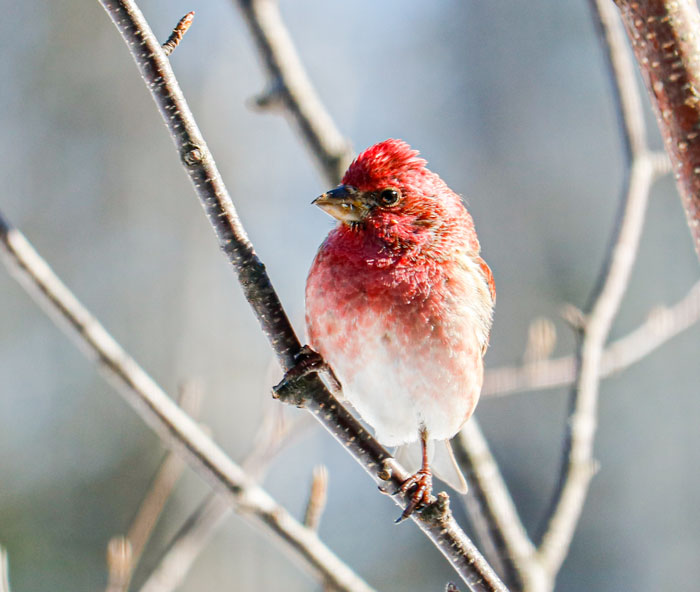
Purple Finch Nesting Habits
During courtship, the male hops near the female with his wings drooping, tail raised, and chest puffed out, then vibrates his wings until he rises a short distance in the air. He may hold bits of nesting materials in the bill and give a soft song during this performance.
Nests are constructed on a horizontal branch or fork of a tree (usually conifers in the east, deciduous trees are often used in the west), often well out from the trunk. Typically about fifteen to twenty feet above the ground but may be lower or up to fifty feet high. The nest is most likely built by the female and is a compact open cup of twigs, weeds, rootlets, and strips of bark, lined with fine grass, moss, and animal fur.
There are usually four to five eggs, sometimes three to six. Eggs are a pale greenish-blue color, marked with black and brown. Incubation is done by females, for about thirteen days. Both parents feed the nestlings. Young leave the nest about two weeks after hatching. They usually have one brood per year, possibly two in the Pacific Coast region.

Purple Finch Range
The purple finch is a short-distance migrant. These birds are erratic migrants that will follow cone crops. Typically, they leave Canadian breeding grounds to winter widely across the central and southeastern U.S, returning to specific regions roughly every other year. The birds that breed in the northeastern U.S. and along the Pacific Coast may not migrate.
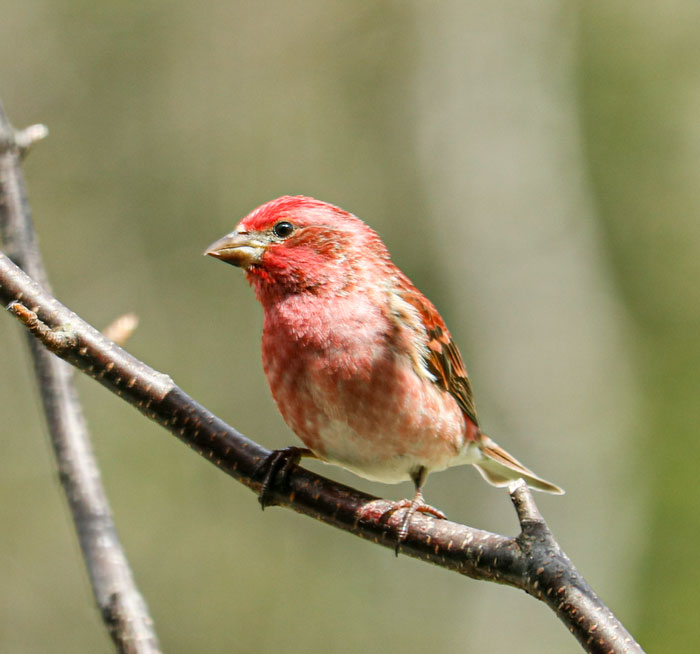
I hope to see more of these finches in my yard and at the feeders as more natural food sources become available in the coming months.
Thank you for reading and I hope you enjoyed learning about these beautiful finches.
Resources used for this post:
allaboutbirds.org & audubon.org
Leave a Reply